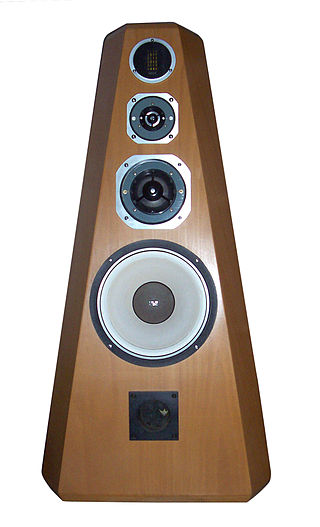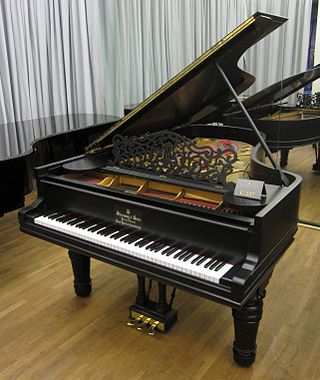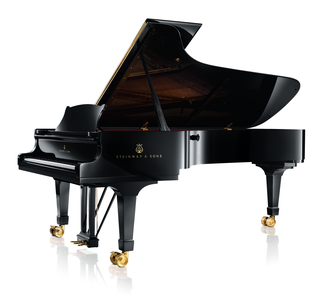This article contains content that is written like an advertisement .(May 2009) |
Steinway Lyngdorf is a brand name of high-end audio systems produced by Steinway & Sons and Lyngdorf Audio.
This article contains content that is written like an advertisement .(May 2009) |
Steinway Lyngdorf is a brand name of high-end audio systems produced by Steinway & Sons and Lyngdorf Audio.
| | This section is empty. You can help by adding to it. (August 2024) |
The goal was to be able to reproduce the sound of a Steinway grand piano so that pianists could not tell whether they were listening to a real piano or a recording. Furthermore, it was hoped that the sound could be compared with the experience of a live symphony or concert. [1]
Steinway Lyngdorf are the world's first systems with digital audio fully integrated. [2] [ dead link ] The systems include an advanced version of Lyngdorf's RoomPerfect technology, which, the company claims, enables the systems to adapt to the acoustic characteristics of any listening environment. [2] The systems are composed partly of gold, brass and aluminum. [3] Each loudspeaker weighs 174 kg. [4] The systems are handmade and it takes more than 170 hours to assemble each system. [4]

High fidelity is the high-quality reproduction of sound. It is popular with audiophiles and home audio enthusiasts. Ideally, high-fidelity equipment has inaudible noise and distortion, and a flat frequency response within the human hearing range.

The piano is a keyboard instrument that produces sound when its keys are depressed, through engagement of an action whose hammers strike strings. Modern pianos have a row of 88 black and white keys, tuned to a chromatic scale in equal temperament.

Steinway & Sons, also known as Steinway, is a German-American piano company, founded in 1853 in New York City by German piano builder Heinrich Engelhard Steinweg. The company's growth led to a move to a larger factory in New York, and later opening an additional factory in Hamburg, Germany. The New York factory, in the borough of Queens, supplies the Americas, and the factory in Hamburg supplies the rest of the world.

A player piano is a self-playing piano with a pneumatic or electro-mechanical mechanism that operates the piano action using perforated paper or metallic rolls. Modern versions use MIDI. The player piano gained popularity as mass-produced home pianos increased in the late 19th and early 20th centuries. Sales peaked in 1924 and subsequently declined with improvements in electrical phonograph recordings in the mid-1920s. The advent of electrical amplification in home music reproduction, brought by radios, contributed to a decline in popularity, and the stock market crash of 1929 virtually wiped out production.

A recording studio is a specialized facility for recording and mixing of instrumental or vocal musical performances, spoken words, and other sounds. They range in size from a small in-home project studio large enough to record a single singer-guitarist, to a large building with space for a full orchestra of 100 or more musicians. Ideally, both the recording and monitoring spaces are specially designed by an acoustician or audio engineer to achieve optimum acoustic properties.

Multitrack recording (MTR), also known as multitracking, is a method of sound recording developed in 1955 that allows for the separate recording of multiple sound sources or of sound sources recorded at different times to create a cohesive whole. Multitracking became possible in the mid-1950s when the idea of simultaneously recording different audio channels to separate discrete tracks on the same reel-to-reel tape was developed. A track was simply a different channel recorded to its own discrete area on the tape whereby their relative sequence of recorded events would be preserved, and playback would be simultaneous or synchronized.
Piano construction is by now a rather conservative area; most of the technological advances were made by about 1900, and indeed it is possible that some contemporary piano buyers might actually be suspicious of pianos that are made differently from the older kind. Yet piano manufacturers, especially the smaller ones, are still experimenting with ways to build better pianos.

Aliquot stringing is the use of extra, un-struck strings in a piano for the purpose of enriching the tone. Aliquot systems use an additional string in each note of the top three piano octaves. This string is positioned slightly above the other three strings so that it is not struck by the hammer. Whenever the hammer strikes the three conventional strings, the aliquot string vibrates sympathetically. Aliquot stringing broadens the vibrational energy throughout the instrument, and creates an unusually complex and colorful tone.

Eric Williams Plaza, also known as the Eric Williams Financial Complex, located on Independence Square, Port of Spain, consists of two of the tallest buildings in Trinidad and Tobago, as well as in the English-speaking Caribbean. It consists of a pair of skyscrapers 22 stories high and 302 ft tall, locally known as the "Twin Towers". Construction on the complex started in 1979 and ended in 1986. The complex was officially opened on March 29, 1986. The architect who managed the construction was Anthony C. Lewis Partnership.

Bösendorfer is an Austrian piano manufacturer and, since 2008, a wholly owned subsidiary of Yamaha Corporation. Bösendorfer is unusual in that it produces 97- and 92-key models in addition to instruments with standard 88-key keyboards.

Stereophonic sound, or more commonly stereo, is a method of sound reproduction that recreates a multi-directional, 3-dimensional audible perspective. This is usually achieved by using two independent audio channels through a configuration of two loudspeakers in such a way as to create the impression of sound heard from various directions, as in natural hearing.

Sound recording and reproduction is the electrical, mechanical, electronic, or digital inscription and re-creation of sound waves, such as spoken voice, singing, instrumental music, or sound effects. The two main classes of sound recording technology are analog recording and digital recording.

Live sound mixing is the blending of multiple sound sources by an audio engineer using a mixing console or software. Sounds that are mixed include those from instruments and voices which are picked up by microphones and pre-recorded material, such as songs on CD or a digital audio player. Individual sources are typically equalised to adjust the bass and treble response and routed to effect processors to ultimately be amplified and reproduced via a loudspeaker system. The live sound engineer listens and balances the various audio sources in a way that best suits the needs of the event.
Akoustik Piano is a virtual instrument developed by Native Instruments for both the Mac OS X and Windows XP platforms. It uses a large collection of audio samples taken from three grand pianos.
Digital Sound Factory is a sound design company that creates sound libraries, known as SoundFont libraries, for playback on synthesizers and computers compatible with Steinberg Cubase, Cakewalk Sonar, Reasonstudios, Steinberg Halion, Native Instruments Kontakt, Apple GarageBand, Apple Logic, Ableton Live, GenieSoft Overture, Finale, Creative Labs Audigy/X-Fi, E-MU Systems EmulatorX/Proteus X, LMMS, FL Studio, MuseScore, Mixcraft, VSamp, SFZ, SynthFont, Ardour, FluidSynth and more.

D-274 is the model name of a concert grand piano, the flagship of the Steinway & Sons piano company, first built in 1884. It is generally described as the first choice of most concert pianists. As of 2017 a D-274 finished in Polished Ebony has a MSRP of US$175,700.

EastWest Studios is a recording studio complex located at 6000 West Sunset Boulevard in Hollywood. Originally constructed by Bill Putnam in the 1960s, the studios are currently owned by sound developer Doug Rogers and managed by Candace Stewart.

The Model K or "Vertegrand" is an upright piano introduced in 1903 by Steinway & Sons. It is the oldest essentially unchanged upright piano design currently in mass production. Although production was interrupted from about 1939 until its reappearance in 1982, the structural design has remained essentially the same for well over a century.

Electric music technology refers to musical instruments and recording devices that use electrical circuits, which are often combined with mechanical technologies. Examples of electric musical instruments include the electro-mechanical electric piano, the electric guitar, the electro-mechanical Hammond organ and the electric bass. All of these electric instruments do not produce a sound that is audible by the performer or audience in a performance setting unless they are connected to instrument amplifiers and loudspeaker cabinets, which made them sound loud enough for performers and the audience to hear. Amplifiers and loudspeakers are separate from the instrument in the case of the electric guitar, electric bass and some electric organs and most electric pianos. Some electric organs and electric pianos include the amplifier and speaker cabinet within the main housing for the instrument.
Four Sabras is a short composition for solo piano by American composer Leonard Bernstein. Each Sabra refers to vignettes or portraits of different fictitious Israeli children.